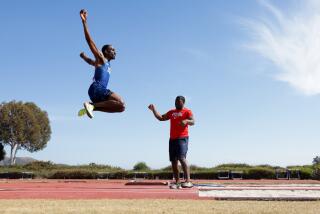Leaping over spinal cord injury, researchers teach a quadriplegic’s hand to move again
In a development that could help restore fine motor movement to patients with brain or spinal-cord injuries, researchers have briefly restored a 24-year-old quadriplegic man’s ability to grasp a cup and perform other everyday tasks with his hand, wrist and fingers.
The effort, reported Wednesday in the journal Nature, set out to circumvent a spinal cord injury and reanimate a limb directly, using reinterpreted electrical signals issued by a patient’s own brain.
In a lab in Ohio, those signals — recorded by a suite of sensors sunk into the subject’s motor cortex — were painstakingly translated into electrical impulses that would command the young man’s fingers to wrap around a cup, his wrist to twist so he could pour out the contents of a bottle and his hand to grasp a stick and stir.
When 24-year-old Ian Burkhart, a quadriplegic injured in a diving accident five years ago, subsequently thought about those movements, a cuff worn around his lower arm would issue electrical commands to his fingers, hand and wrist to perform them.
Researchers described their experiment in brain-machine interfaces as a way to bypass a severed connection between brain and limbs and restore some independent movement to those with grievous injuries.
Others working in this field have used recorded sequences of brain signals to make a variety of robotic devices move on command. But the latest effort to be reported, which occurred in a lab two years ago, sent those messages directly to distant muscles via a cuff wrapped around the forearm.
Receiving those impulses through the cuff, the muscles in Burkhart’s hand and wrist — which at that time had been immobilized for three years after his spinal cord was damaged — briefly went back to work.
“That was just like the flicker of hope. This is something that is working,” said Burkhart in a news conference this week. “I will be able to use my hand again. … With enough people working on this and enough attention, this may be something I can use outside, and it could really improve my quality of life.”
Study co-author Chad Bouton, an engineer at the Feinstein Institute for Medical Research in Manhasset, N.Y., said, “We literally are connecting the brain to the body.”
In the current effort, Bouton said, “We are seeing the potential for spinal cord injury. But we now realize if we can reroute signals around a spinal cord injury, then why couldn’t we in the future reroute signals around an area of the brain that’s been injured by stroke or brain trauma?”
At the same time, Bouton and his colleagues acknowledged there is much work to be done — at least a decade’s work — before small-scale efforts like these will yield devices capable of helping some brain- and spinal cord-injured patients outside the lab.
“This research opens many options, which is wonderful for patients,” said Dr. Miguel Nicolelis, who has pioneered the use of brain-machine interfaces for those with brain and spinal cord injury. “Different people have different injuries, which will require many different approaches.”
Nicolelis called the latest report “another variation” on efforts to restore function by transmitting the brain’s commands past a broken connection. But he underscored that implementing such measures on a large scale will require many improvements over the relatively crude devices used in the study.
To produce a wide range of movements outside of a lab, he said, the devices that record brain activity will have to be capable of listening to vastly more neurons, to be more sensitive and to remain functional in the brain for much longer than they do now. (Because they are a foreign body surgically implanted, microarrays such as the one used on Burkhart eventually kill off surrounding brain cells and stop working.)
And ultimately, researchers will need to show that these devices do more than issue commands, Nicolelis said. Researchers will need to show that by restoring disrupted connections and reanimating idle muscles, their interventions are promoting the actual regeneration of lost feeling in patients.
See the most-read stories in Science this hour >>
“They didn’t say anything about what happened when they turned the system off,” said Nicolelis, who in his lab is seeing evidence of renewed sensory perception on the part of injured subjects. “Did the patient improve? Most studies show that sensory perception and motor recovery go together. The clinical evaluation was a little superficial.”
With a cervical spinal cord injury between his fifth and sixth vertebrae, Burkhart is young, injured relatively recently and has some residual ability to move his shoulders and upper arms. In addition to having an array of recording electrodes surgically implanted in his brain, Burkhart attended three sessions weekly for 15 months to learn to use the “neural bypass system.”
In those early sessions, a 96-channel array of electrodes sunk into Burkhart’s motor cortex recorded the firing of roughly 50 brain cells — and eventually several hundred, researchers said — as he imagined moving his hand, wrist and fingers in various ways. Researchers used that information — a gigabyte’s worth of data every three minutes — to generate specific electrical commands to be issued later through the skin by Burkhart’s cuff.
Translating brain signals into commands required the extensive use of computer software that detects and distills regular patterns in data. The particular sequence of signals each human uses to command certain movements is also highly individual. So generating a list of commands unique to a given subject is a painstaking task that takes hours of repetition and a vast amount of computing.
“Initially, we would do a short session, and I was completely mentally fatigued and exhausted, along the lines of taking a six- to seven-hour exam,” said Burkhart, who was 19 when he dove into a wave and was pushed head-first into a sandbar during a post-college vacation with friends.
“They’re asking me to think about how to move my finger or hand, when it’s something you don’t even think about,” Burkhart said. “The first 19 years of my life, it’s something I definitely took for granted: My hand just does what I tell it to. So you have to break down each part of that motion, and think about it in a more concentrated way,” he added.
With time and practice, he said, it became easier.
Bouton and his co-authors — neurosurgeon Ali Rezai of Ohio State University’s Neurological Institute and engineer Nick Annetta of the Battelle Memorial Institute in Columbus, Ohio — set out to build a system to bypass Burkhart’s injured spinal cord that would minimize the use of assistive devices and directly recruit muscles idled by the disrupted chain of command.
“The control has been taken away” from patients with spinal cord injury, Rezai said. “So it’s significant psychologically to see your own limb functioning again. We want the patients to use their own body parts and limbs that have become dysfunctional.”
Burkhart echoed that sentiment.
“You’re not going to be looked on as, ‘Oh, I’m a cyborg now because I have this big huge prosthetic on the side of my arm. It’s something a lot more natural and intuitive to learn because I can see my own hand reacting.”
Follow me on Twitter @LATMelissaHealy and “like” Los Angeles Times Science & Health on Facebook.
MORE SCIENCE NEWS
More babies, fewer multiple births, are resulting from assisted reproduction
Napster cofounder Sean Parker gives cancer immunotherapy development a boost







